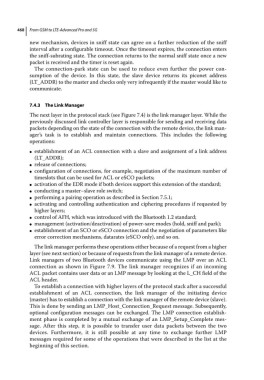Page 482 - From GMS to LTE
P. 482
468 From GSM to LTE-Advanced Pro and 5G
new mechanism, devices in sniff state can agree on a further reduction of the sniff
interval after a configurable timeout. Once the timeout expires, the connection enters
the sniff‐subrating state. The connection returns to the normal sniff state once a new
packet is received and the timer is reset again.
The connection‐park state can be used to reduce even further the power con-
sumption of the device. In this state, the slave device returns its piconet address
(LT_ADDR) to the master and checks only very infrequently if the master would like to
communicate.
7.4.3 The Link Manager
The next layer in the protocol stack (see Figure 7.4) is the link manager layer. While the
previously discussed link controller layer is responsible for sending and receiving data
packets depending on the state of the connection with the remote device, the link man-
ager’s task is to establish and maintain connections. This includes the following
operations:
establishment of an ACL connection with a slave and assignment of a link address
●
(LT_ADDR);
release of connections;
●
configuration of connections, for example, negotiation of the maximum number of
●
timeslots that can be used for ACL or eSCO packets;
activation of the EDR mode if both devices support this extension of the standard;
●
conducting a master–slave role switch;
●
performing a pairing operation as described in Section 7.5.1;
●
activating and controlling authentication and ciphering procedures if requested by
●
higher layers;
control of AFH, which was introduced with the Bluetooth 1.2 standard;
●
management (activation/deactivation) of power‐save modes (hold, sniff and park);
●
establishment of an SCO or eSCO connection and the negotiation of parameters like
●
error correction mechanisms, datarates (eSCO only), and so on.
The link manager performs these operations either because of a request from a higher
layer (see next section) or because of requests from the link manager of a remote device.
Link managers of two Bluetooth devices communicate using the LMP over an ACL
connection as shown in Figure 7.9. The link manager recognizes if an incoming
ACL packet contains user data or an LMP message by looking at the L_CH field of the
ACL header.
To establish a connection with higher layers of the protocol stack after a successful
establishment of an ACL connection, the link manager of the initiating device
(master) has to establish a connection with the link manager of the remote device (slave).
This is done by sending an LMP_Host_Connection_Request message. Subsequently,
optional configuration messages can be exchanged. The LMP connection establish-
ment phase is completed by a mutual exchange of an LMP_Setup_Complete mes-
sage. After this step, it is possible to transfer user data packets between the two
devices. Furthermore, it is still possible at any time to exchange further LMP
messages required for some of the operations that were described in the list at the
beginning of this section.

